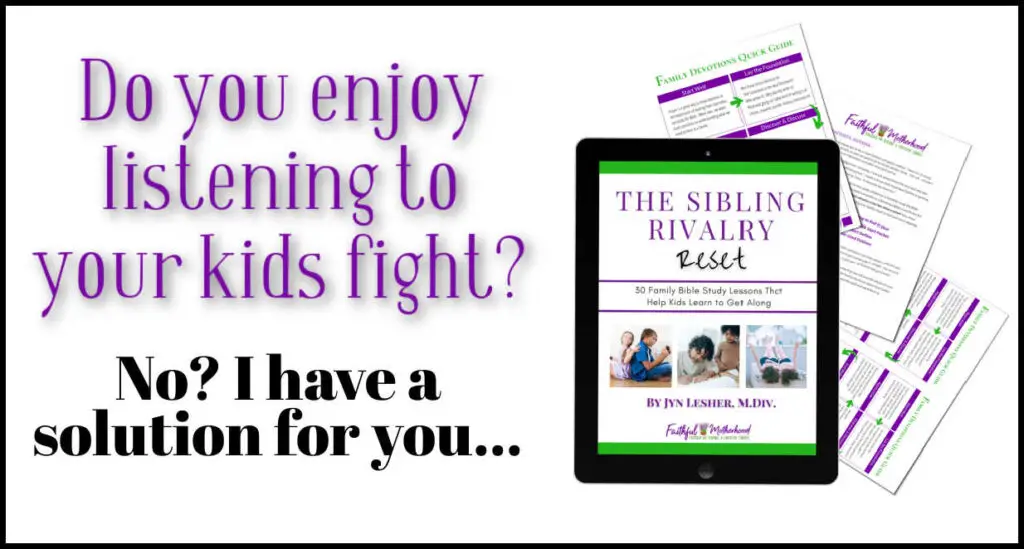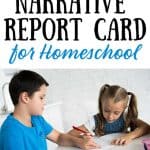Grading. I find grading to be one of the most frustrating and arbitrary things about homeschooling. Are you overwhelmed by the idea of grading too? I found a narrative report card to be the ideal solution to grading in our homeschool for younger students.
Our state homeschooling laws, like many across the nation, require that we keep a grade report at the same interval as the public schools. So, basically four times a year, we are to assess where our students are in the learning process.
Daily Student Assessment?
Now to be fair, as a homeschooling mom, I am doing this every day. I am always assessing where they are in their schoolwork.
Is this child on track to finish their math book by the end of the year? Has she fallen behind?
My eldest daughter has a homeschool co-op class that sets the pace for working through her math book. The younger one knows that she needs to keep up with her big sister because they have the same number of lessons in their books.
Our students are not just students but our children. We want the best for them, and so we are consistently assessing where they are and where we think that they need to be.
We are assessing not only their academic progress but where their emotionally and spiritually as well.
What is the Purpose of Grades?
In public school, grades are useful in comparing students with one another. If one student is the best in the class, then they get the best grade.
If you are dealing with twenty-five students and the government, you need to have this kind of system in place. In our homes, however, we can have a different standard.
For us, the goal is mastery. I want my children to master the material. If they miss three items on their math, then we go back and work those problems together to make sure they fully understand the new concept before we move on.
A public school teacher does not have that kind of time or flexibility to tailor the learning to one student.
In our homeschool, the assignment of a letter grade seems arbitrary and out of keeping with our whole approach. There is no one to compare your student to when they are in a class of one.
For those families that value excellence, there is always room for improvement. The assigning of a grade is challenging for homeschool families.
My solution: The Narrative Report Card
The Narrative Report Card is the ideal solution to the challenge of homeschool grading. Instead of a listing of subjects with letter grades, I prefer a narrative report card to a traditional report card.
It is indeed easier to create a conventional grade report with a list of classes and just put some letters down along the side.
Johnny Smith – 3rd Grade
- Math – A
- English – A
- Handwriting – A
- History/Civics – A
A traditional grade report is quick and easy, but it doesn’t give us much information. Face it, as homeschoolers we often struggle with justifying what our children are actually learning.
As homeschool parents, we sometimes struggle with Impostor Syndrome when we are questioned as to if we are qualified to teach our children. A narrative grade report is a perfect solution to prove what our children are learning.
Interested in learning more about Impostor Syndrome? “Beat Impostor Syndrome: 5 Ways to Be More Confident Parent“
A Narrative Report card takes more time, but it also serves as an excellent record of what your child has learned during that period. It is simple when you can just record the information that your student has covered.
Instead of just reporting a grade for 5th-grade science, the narrative report allows for a description of what all that science program entailed.
The Narrative Report Card also blesses Mom
We can get so caught up in the day to day struggles of homeschooling that we need the opportunity to stop and realize how far our children have come. Narrative Quarterly homeschool reports offer an opportunity to celebrate all that our children have learned thus far.
You can include all of the experiments that you have lovely pulled together for your children. It allows you to celebrate all the new ideas explored and learned.
This is not just a document for the state but is a record of all that YOU have done in leading your homeschool. This is an excellent report for those days when you feel defeated and overwhelmed.
A narrative grade report is a wonderful document for a spouse that still has some doubts and fears about how homeschooling stacks up with the public school. You may even consider sharing it with grandparents who need assurance as well.

Step #1 – Organizing Your Narrative Report Card
First, determine which categories you need to cover. In our state, we are required to teach reading, writing, spelling, grammar, history, civics, and mathematics.
These are the subjects that we would cover anyway. Use these categories to set up your main categories for your quarterly narrative report.
You can combine some of the requirements into a larger group. For example, I would combine history and civics. I would also create a category called Language Arts that included reading, writing, spelling, and grammar.
For each subject, record the books or texts used. Outline the basic skills learned or ideas covered.
Share a joy or connection that your child made. (I.e., Sally was fascinated with the study of Roman war machines.) A narrative grade report is not just to meet a state requirement, but it is a way of preserving your child’s passions and interests as well.
Step #2 – Narrative Report Card: Sample Math Narrative
A sample entry might look like this: Completed Lessons 1- 30 of Saxon Math 4/5. Homework and Tests all corrected for mastery. The growth area for the year is memorization of the 14s & 15s
If you participate in Classical Conversations, or another program that cycles back through the same set of facts, you might organize your math narrative report card area this way. (You would include your math textbook information as well.)
- Year 1 – Recognizing multiples of 2,3,4, & 5 Working on memorizing addition facts
- Year 2 – Memorizing multiples of 6, 7,8,9, 10, 11, 12, 13, 14, & 15. He is working on memorizing the subtraction facts.
- Year 3 – Memorizing times tables for 2-5 up to 15
- Year 4 – Add more times tables all the way up through 15 x 15
- Year 5 – Memorizing division equations.
Step #3 – Narrative Report Card: Sample Science Narrative
We study the same basic science facts over a three-year cycle. Each year, we come back to that cycle we go deeper in our exploration and study. Include a list of the books that you read or the experiments that you conducted.
For example, we added 50 more pages to our nature observation journal. This doesn’t have to be just a bland written journal. Include photos from your child’s school work, journals, geography tracing, and nature explorations.
Year 1:
- We completed a physical science textbook.
- The student conducted ten additional experiments.
- She entered a science project in our homeschool co-ops annual science fair.
- She read eight extra books for further exploration in the area.
- She collected rock samples on four hikes.
- She also visited a natural history museum.
That family hike on Saturday afternoon can count as school time. As homeschoolers, we don’t usually just go on a hike. We are creating a lifestyle of learning.
Practically that means that we are identifying the different plants, rocks, and animals that we see. You don’t have to document only the education done during school hours; you can count all of their learning!
Step #4 – Narrative Report Card: Language Arts
Language Arts is a broad category that covers reading, writing, handwriting, and spelling. My family does a formal grammar and writing program in the upper elementary ages.
However, we never do a formal reading program in the younger years. Instead, we ensure that our children have rich reading material to read from and that they actually read. I personally would include typing in this category as well.
Sample ideas for Language Arts inclusions are:
- Include a list of books read throughout the year.
- Added 50 new words to the spelling/vocabulary list
- Completed Institute for Excellence in Writing: Ancient History text
- Completed a 24-week grammar class at our homeschool co-op. Memorized four grammar Charts.
You can get more ideas of what belongs in this category from a Charlotte Mason perspective at SimplyCharlotteMason.com
Step #5 – Narrative Report Card: Other Subjects/Interests
Remember to include all of the learning that your children are engaging in during your school year. The experiences that they have in scouting, church, and the community are all rich areas of learning.
- Participated in the Community Play
- Played Fall Soccer
- Played Spring Softball
- Mastered learning to ride a bike
- Earned his special award in Scouts
You are NOT a Teacher Imposter
Don’t let grades overwhelm you or cause you to worry. Our culture can sometimes make us feel like impostors when it comes to assigning grades to our homeschooled children.
You are doing a great job! Your children are learning! Assign grades that align with your heart. You can assess to bless with a narrative report card.
Take heart! God gave those children to you to steward and as long as you are working until the Lord and not to man – you have your priorities straight.
Use this model of narrative grade reporting to record all of the work and progress that you and your student are making. Make it a blessing and not a curse. Use this easy plan and then get on to the more important things – your family.
Homeschooling is about more than a textbook. Learn why in: “Skills Before Content: Focus on the Skills of Learning.”

The voice behind FaithfulMotherhood.com is Jyn. She is a veteran homeschool mom of three. More than just a pastor’s wife, she holds a Master of Divinity degree and has served in church leadership for over 20 years. Her passion is equipping parents to live out their calling as the number one faith influencer for their children. She longs to see moms empowered by God’s Word and transferring that love to their children through daily Bible study and family devotions.













